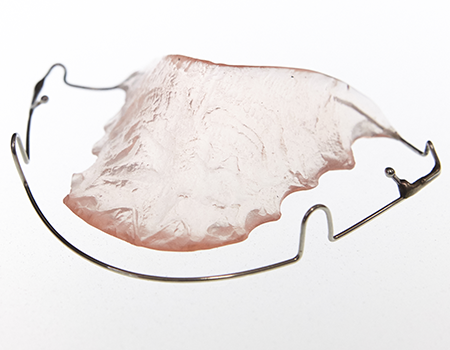Plates

Plates are a type of removable orthodontic appliance which may be used to correct minor issues. This type of appliance is usually used when only one or two teeth require adjustment – such as a gap between two teeth. More complex issues involving multiple teeth or bite correction would generally require a fixed appliance such as braces or an expansion appliance.
Each case is different so you will be instructed when the plate is fitted as to how and when to wear the plate. Some cases require the plate to be worn only during sleeping hours, whilst others require it to be worn full-time (all day and night).
Adjusting to your plate
Your new plate may cause some discomfort or tightness/firmness as you are first wearing it or after an appointment where the plate has been activated. This is normal, as the plate is moving your teeth and doing its job to give you a perfect smile. In the beginning you may need to wear your plate for just a few hours each day, allowing your mouth to get used to it. After the first few days you can increase the wear to the required amount.
In the beginning the plate will affect speech and you may talk a little funny, however this will improve after a few days – the more you talk the faster this will happen!
Pain Relief
You can seek relief through a mild analgesic, such as Nurofen or Panadol. Remember to ask your parents first and always follow the directions on the packet or talk to a pharmacist for further advice.
Stick to eating soft foods such as yoghurt, banana or soup to reduce any further discomfort.
The pain should usually settle after 2-3 days.
In the rare case you are experiencing a more severe level of pain, we advise remove your plate and contact our friendly receptionists who can tell you whether or not you need to come in for another visit.
Eating or Brushing with a plate
Remember to remove your plate when eating, drinking hot liquids, swimming, playing sport or brushing your teeth. This ensures that the plate will not be broken. Removing the plate whilst eating will prevent food becoming lodged in between the plate and your mouth or teeth. Removing the plate will also allow you to brush and clean your teeth more thoroughly.
Caring for your plate
It is important not to flick the plate in and out with your tongue as the plate will break.
When inserting the plate, position it below your top row of teeth (or above your bottom row) and press firmly on the plastic to push it into position. If the plate is not sitting correctly, remove it and try again.
To remove the plate, place a finger on the clasps on the back teeth at each side of your mouth then pull the plate down off the teeth. Remember to never pull on the springs or front wire as this may damage the plate.
When the plate is not in your mouth be sure to keep it safely in the box provided. Repairing or replacing your plate may incur fees from the laboratory.
